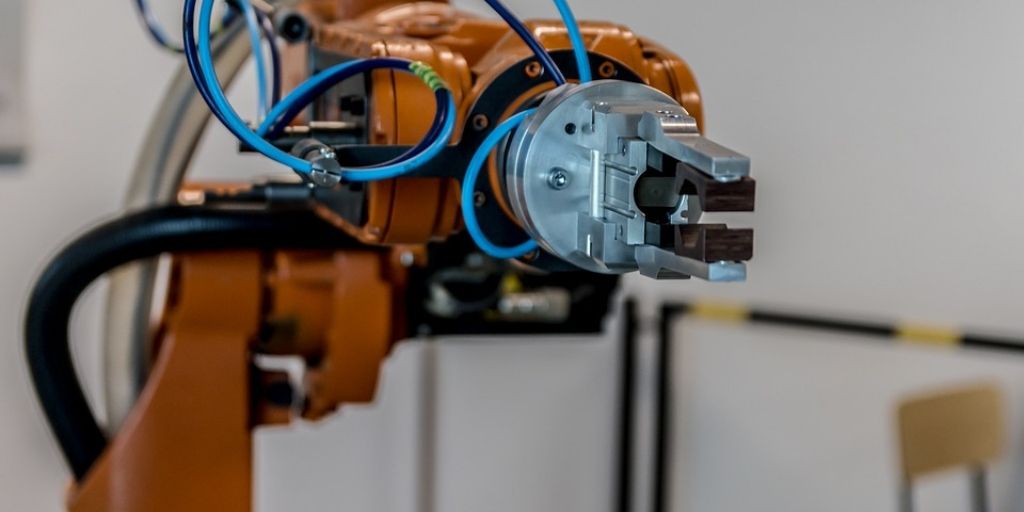
by Fronetics | Aug 1, 2019 | Blog, Current Events, Supply Chain
Its disruptive data-recording and -securing technology begs the question: Could blockchain change the supply chain fundamentally and for the better?
Highlights:
- Blockchain offers the ability to record, track, and verify any transaction.
- Potential benefits include greater transparency and security.
- Supply chain operations could record, track, and share information more accurately and easily.
Ever since blockchain technology emerged, experts and industry analysts have been making various predictions for how it will impact their sectors. The supply chain, in particular, has been popularly theorized to be impacted by the technology.
It’s becoming increasingly clear that blockchain has transformative potential when it comes to the future of the supply chain. Here is a summary of what we’re seeing so far.
What is blockchain?
First conceptualized in 2008 by a programmer or group of programmers operating under the name Satoshi Nakamoto, blockchain was originally part of the implementation process of the cryptocurrency bitcoin. Essentially, it’s a distributed database — and it’s special because it keeps records of digital data or events in a way that makes them resistant to being altered or tampered with.
Blockchain allows data to be accessible to many users, even allowing them to add to it. But the original information is immutable, and it leaves a permanent and public chain of transactions. SupplyChain247 uses the following helpful analogy:
If the entire blockchain were the history of banking transactions, an individual bank statement would be a single “block” in the chain. Unlike most banking systems, however, there is no single organization that controls these transactions. It can only be updated through the consensus of a majority of participants in the system.
Writing for Forbes, early-adopter researcher Dan Woods describes blockchain as “key for creating an unalterable, trusted record of certain types of transactions.”
Experts are starting to see the potential for blockchain’s use in other arenas, particularly the supply chain. The blockchain ledger “can be used to record, track, and verify trades of virtually anything that holds value,” says Jon-Amerin Vorabutra, VP of Process and Technology at Nova Molecular Technologies.
How will blockchain change the supply chain?
The ability to track any type of transaction securely and transparently is huge for supply chain applications. “Every time a product changes hands, the transaction could be documented, creating a permanent history of a product, from manufacture to sale,” writes Vorabutra. Imagine the reduction in time delays, wasted costs, and errors.
Syncsort, a company building the infrastructure necessary to support the modern data supply chain, has detailed predictions about how blockchain will impact the supply chain, reported by Woods. The company’s CTO, Dr. Tendü Yoğurtçu, identifies blockchain as falling under one of four larger “megatrends” that Syncsort is monitoring: data governance.
“We have some products that we will announce that are blockchain-ready, and data governance will continue to be the umbrella theme for us with blockchain because it’s an evolving data platform and data architecture,” says Yoğurtçu.
Experts and analysts across the industry believe that blockchain can improve the supply chain in the following ways:
- Recording the quantity and transfer of assets — like pallets, trailers, containers, etc. — as they move between supply chain nodes (Talking Logistics)
- Tracking purchase orders, change orders, receipts, shipment notifications, or other trade-related documents (SupplyChain247)
- Assigning or verifying certifications or certain properties of physical products; for example determining if a food product is organic or fair trade (Provenance)
- Linking physical goods to serial numbers, bar codes, digital tags like RFID, etc. (SupplyChain247)
- Sharing information about manufacturing process, assembly, delivery, and maintenance of products with suppliers and vendors (SupplyChain247)
The benefits of blockchain for the supply chain
Blockchain technology is ideal for supply chain management. Supply chain companies frequently struggle with lack of transparency, particularly those with complex supply chains. This makes it difficult to isolate errors. This is where blockchain comes into play.
“Because of the way transactions are recorded and tracked using blockchain technology, it makes it much easier to see everything happening in real time,” says Miranda Marquit, of Investopedia.
Additionally, blockchain will allow for increased scalability in the supply chain. Since data cannot be changed or added to, essentially any number of participants can access data from any number of touchpoints. The technology also allows for greater security, since a shared, immutable ledger keeps data from being tampered with.
Finally, blockchain can open the doors for greater innovation in the supply chain. According to Vorabutra, “Opportunities abound to create new, specialized uses for the technology as a result of the decentralized architecture.”
What ways are you predicting blockchain will change the supply chain?
Related posts:


by Fronetics | Jul 31, 2019 | Blog, Current Events, Marketing, Social Media
Also this month in social media news: Facebook strives to attract content creators, and Pinterest debuts new video tools for brands.
Highlights:
- Less than a month after Facebook released details of its new cryptocurrency, the project has met a stumbling block from Fed Chairman Jerome Powell.
- Newly released statistics highlight key growth metrics and lay out expectations for digital marketing in the second half of 2019.
- Pinterest’s new video tools as well as updates from Facebook are geared to content creators and brands.
It’s hard to believe it’s already July and 2019 is at its halfway point. It’s a time when organizations are evaluating their performance thus far, and setting goals for the second half of the calendar year. To that end, both Mobile Marketer and Marketing Dive published key digital marketing growth statistics, and we’ve got the highlights for you below.
Last month, Facebook made news by releasing details of its new cryptocurrency, Libra. Now the social media giant has hit a roadblock, in the form of Fed Chairman Jerome Powell calling for a halt until serious concerns are addressed. Facebook is also making news this month by taking a page out if its competitors’ books in its attempt to attract more online content creators. Read on for details on these social media news items from July 2019.
Fed Chief Calls for Facebook to Halt Libra Project Until Concerns Are Addressed
Following closely on the heels of Facebook’s releasing details of its planned Libra cryptocurrency, U.S. Federal Reserve Chairman Jerome Powell said that the project “cannot go forward” until serious concerns are addressed. “Libra raises many serious concerns regarding privacy, money laundering, consumer protection, and financial stability,” Powell said before the U.S. House of Representatives Financial Services Committee.
The Fed chief’s tough comments not only underscore the regulatory hurdles facing Libra, but put pressure on the project, and dented the price of Libra’s forebear, bitcoin. The price of bitcoin fell by around 7% during his 3-hour testimony. Powell also called for regulatory review of the project to be “patient and careful,” while pointing to the fact that existing rules don’t adequately fit digital currencies.
“It’s something that doesn’t fit neatly or easily within our regulatory scheme, but it does have potentially systemic scale,” said Powell. “It needs a careful look, so I strongly believe we all need to be taking our time with this.”
Facebook spokeswoman Elka Looks responded to the testimony in an email to Reuters: “We are very much aligned with the Chairman around the need for public discourse on this,” wrote Looks. “This is why we along with the 27 other Founding Members of the Libra Association made this announcement so far in advance, so that we could engage in constructive discourse on this and get feedback.”
2019 Key Digital Marketing Growth Statistics Released
The midyear release of statistics from Marketing Dive and Mobile Marketer are important for brands and marketers to pay attention to. In the ever-shifting world of digital marketing, these statistics and trends offer valuable insight into where resources and time are best devoted.
Highlights from the reports include:
- Global online advertising spend is on track to grow 7% this year. That’s up from the 4% forecast in December 2018.
- Location-based marketing will likely grow 14%, reaching $24.4 billion in advertising spending by the end of 2019.
- 43% of all advertisers plan to increase spending on influencer marketing by April of 2020.
- Social referral traffic to retail ecommerce sites has grown by 110% in two years.
Facebook Strives to Attract More Content Creators
In an effort to attract more content creators to its platform, Facebook is giving videos more ways to make money. Observers have noted that the reigning social media giant is “pulling inspiration from other platforms to let you throw cash at your favorite video creators in the form of subscriptions or tokenized ‘stars’ that pay them a penny.”
Facebook’s announcement of its new video developments comes just ahead of VidCon, the world’s biggest conference for online video creators. It follows on the heels of three years of investments in the network’s video services and is in line with consumer trends toward video consumption.
Pinterest Debuts New Video Tools for Brands
Image-curating platform Pinterest is ramping up its video capabilities, in line with a larger consumer shift in viewing habits and a boost from advertisers in spending on social video. New video features include an improved uploader, video tab, lifetime analytics, and Pin scheduling.
The updated video uploader “enables businesses and creators to seamlessly upload video directly to Pinterest to engage with new and existing audiences, and access latest metrics,” according to the announcement.
Pinterest’s announcement points out that unlike on other platforms, videos don’t disappear (as they do on Instagram and Facebook Stories after 24 hours). To that end, their video analytics tool will allow businesses to gain insight into a video’s performance over its lifetime.
Related posts:


by Fronetics | Jul 25, 2019 | Blog, Manufacturing & Distribution, Marketing, Marketing Automation, Robotics & Automation, Supply Chain
Implementing robotics and automation for manufacturing can be costly and a challenge for public perception – but, ultimately, these technologies are crucial assets for the industry.
Highlights:
- Hurdles companies face concerning automation include public perception, potential safety hazards, and cost.
- However, robots actually make factories safer and protect human workers from having to perform dangerous tasks.
- Advantages of automation include decreased long-term costs, reduced error rate, improved productivity, and enhanced data collection.
As machine learning, or Artificial Intelligence (AI), gains sophistication and technologies continue to improve, supply chain companies are increasingly needing to evaluate the benefits and pitfalls of robotics and automation for manufacturing.
While current evidence suggests that experts are correct in predicting that automation will prove a significant competitive advantage, manufacturing companies are often faced with equally significant hurdles when it comes to implementing these technologies.
So, on balance, are robotics and automation for manufacturing assets, or do they present insurmountable hurdles? Let’s look at the case for each.
3 challenges of robotics and automation for manufacturing
1) Perception
When companies begin considering or implementing robotics and automation for manufacturing, they do so in the context of a public steeped in the kind of sci-fi lore that breeds hysteria on this issue. While public fears of Cylons and the like taking manufacturing jobs may seem like frivolous concerns, the battle that companies face when it comes to public perception is quite significant and should not be overlooked.
In addition to the more hysterical fears of robot uprising, manufacturing companies are faced with the need to combat negative public perception and employee fears when it comes to replacing traditional manual labor with capitalized assets. In short, the fear that “robots are taking our jobs” should not be underestimated as a challenge faced by companies considering manufacturing automation.
2) Dangers
In addition to cultural perceptions of robots as potentially threatening, there are real safety concerns when it comes to robotics and automation for manufacturing. A notorious accident in a Volkswagen factory in Germany, in which a worker was killed by a malfunctioning robot, has been widely reported in the media and serves as a cautionary tale about the dangers posed by automation.
Manufacturers seeking to implement automation are faced with the task of ensuring that factories remain safe for humans and robots to work collaboratively. This requires investment in safety features, as well as training and oversight.
3) Implementation costs
Perhaps the biggest hurdle to companies’ acquisition of robotics and automation for manufacturing is the cost. While these technologies are becoming more affordable, the high initial capital outlay presents a serious barrier, particularly for smaller and midsized manufacturers.
In addition to the costs of equipment, there are expenses associated with maintenance, compliance, software, and human worker training. Companies may be aware of the long-term benefits of automation but unable mount the initial costs or stomach ongoing expenses.
Robotics and automation for manufacturing: the case for overcoming the hurdles
Now it’s time to look at how these technologies are assets and whether it’s worth facing the challenges associated with implementing them.
Robots aren’t here to replace humans.
When it comes to combatting the public perception that robots will render humans obsolete, there’s one simple truth that sums it up best: robots will not replace humans. In fact, automation works best alongside human workers and maximizes the strengths of each, leading to enhanced employee value. Automation frees up human workers to work in their core competencies, focusing on strategic work, oversight, and administration.
Automation helps make factories safer.
While the dramatic examples of robots causing injury and death are harrowing, and deserve attention, it’s important not to sweep under the rug the fact that automation actually makes factories much safer for human workers. By performing tasks that put humans at risk, robots can remove workers from traditionally hazardous situations or exposure to harmful materials.
As these technologies develop, they are becoming increasingly safe and include provisions that facilitate working collaboratively with humans. Robotics can increase access to difficult or dangerous locations. Improvements in sensors, dexterity, artificial intelligence, and trainability are helping to ensure that robotics and automation for manufacturing are safe.
Automation as a value driver
While costs associated with implementation and maintenance may be significant, arguably, with the competitive advantages presented by robotics and automation for manufacturing, companies can’t afford not to automate.
Robots improve the speed and accuracy of routine operations, reducing costly error rates and increasing productivity. They decrease long-term costs, provide labor utilization and stability (particularly when labor is in short supply), and optimize picking, sorting, and storing times. The vastly improved data collection provided by automated manufacturing means reducing the frequency of costly inventory checks while increasing accuracy.
The bottom line: the hurdles presented by robotics and automation for manufacturing are well worth navigating.
Related posts:


by Fronetics | Jul 24, 2019 | Blog, Leadership, Logistics, Supply Chain
Corporate social responsibility is no longer optional; it’s expected. Here are five trends that today’s business leaders need to be aware of.
Highlights:
- 75% of millennials expect their employers to take a stand on social issues.
- In a polarized political climate, successful corporate social responsibility requires authenticity and open dialogue.
- Companies are increasingly measuring the results of corporate social responsibility campaigns, ensuring that they align with business objectives.
Corporate social responsibility in increasingly becoming a buzzword — and a consumer expectation. Businesses are facing external and internal pressures to act in socially responsible ways, tackling issues related to sustainability, social advocacy, and more. And, corporate leaders, in response, are increasingly paying attention.
A recent study by Glassdoor found that 75% of employees between the ages of 18 and 24 expect employers to take a stand on social issues ranging from immigration and equal rights to climate change. Not only that, 84% of U.S. workers of all ages believe that companies have an important role to play in proposed legislation, regulation, and executive orders.
In 2019, donating to charities is no longer enough. Writing for Forbes, Community Health Charities President and CEO Thomas Bognanno points out that today, “corporate leaders are aligning social impact and employee engagement with business objectives.” Companies are evaluating the effects of corporate social responsibility to ensure that these efforts “demonstrate real value to the company.”
Staying abreast of trends, expectations, and issues related to corporate social responsibility is a must for today’s business leaders.
5 corporate social responsibility trends leaders should know about
1) Authenticity
Let’s start with one that’s likely here to stay. Social media has rapidly accelerated the expectation that companies should be both authentic and transparent in their digital marketing. It’s had a similar effect when it comes to corporate social responsibility.
Companies are learning to actively promote authentic social engagement, whether through encouraging internal dialogue among employees or company leaders’ sharing personal messages related to important issues. From Dan Schulman of PayPal standing up against North Carolina’s so-called “bathroom bill” to Chick-fil-A’s Dan Cathy voicing his opposition to gay marriage, corporate leaders across the political spectrum are increasingly speaking out authentically.
As Bognanno points out, however, “Aligning a corporate brand with social issues can backfire if it’s not done thoughtfully and with authenticity, so be sure to understand your brand, measure stakeholder interest, and align with issues that resonate.”
2) Dialogue
In times of deep political and social division, companies and corporate leaders are increasingly recognizing their role in fostering dialogue. In fact, one expert predicts that dialogue is replacing taking a stand when it comes to corporate social responsibility in 2019.
“Faced with the prospect of a divided government in Washington, a looming presidential election in 2020, and the fact that some companies are seeking more federal oversight of their work in areas like data security, businesses will tone down their public advocacy in favor of more dialogue on the issues,” writes leadership strategy expert Timothy J. McClimon.
Whether increased dialogue comes at the expense of advocacy or goes hand-in-hand with it, the fact is that it’s a trend to watch. Companies like Campbell’s are stepping up their efforts to engage employees in social dialogue, using platforms like Workplace by Facebook. Externally, Campbell’s UnCanned by Campbell’s campaign has promoted open conversations on “real food,” GMOs, MSG, BPA, and more.
3) Educational opportunities
Workplaces are arguably far more complex environments than they were a few decades ago. The #metoo movement, for example, has thrown glaring light on issues of sexism and sexual harassment, and companies are tackling them not only with policy, but through education to enact real and lasting changes to corporate culture.
Whether it’s internal training classes, peer-to-peer dialogues, or formal executive education classes in corporate social responsibility at programs like Harvard and Wharton, companies are encouraging personnel to educate themselves on the complex issues we face in the modern workplace.
4) Preventing or mitigating disasters
Disaster relief has been considered a primary corporate social responsibility for generations. American Express, for example, has made disaster relief grants dating back to 1872. However, as natural disasters become more and more frequent globally, companies are looking at new approaches to tackling this issue.
While companies are expected to continue their relief efforts for natural disaster victims, there’s a trend toward increasing proactivity. This means helping communities build up resiliency, as well as taking a tough look at business practices that may be leading to or worsening natural disasters.
“While most natural disasters cannot be prevented from occurring, the impact on people can be mitigated or even largely eliminated through better urban and rural planning, and more restrictions on building and development,” writes McClimon. Companies are increasingly seeing these efforts as a key aspect of their corporate social responsibility.
5) Measuring results
Corporate social responsibility is increasingly being viewed not as a nicety, but as an aspect of doing business – and that means it needs to be measured, evaluated, and adjusted accordingly. Benefits of corporate social responsibility range from increased employee satisfaction to increased creativity, and companies are looking to quantify results.
Recent campaigns from Nike and Gillette have demonstrated that a strong stand on important and controversial issues can have varying consequences for a company’s bottom line. In its essence, corporate responsibility is about serving global interests without regard for gain, but companies are increasingly recognizing that for advocacy to be effective, it needs to align with business interests.
Related posts:


by Fronetics | Jul 23, 2019 | Blog, Marketing, Social Media, Video Marketing
Videos drive greater conversion rates and increased leads. Here are four takeaways from Vidyard’s 2019 State of Video in Business Report.
Highlights:
- Over 82% of businesses reported greater investments in video last year
- Vidyard’s report stated that high-value video content has become a key factor in SEO and ranking.
- Aside from just tracking views, businesses will also track engagement time, drop-off rates, and reach across all channels, as well as the impact of video on lead generation and revenue.
Video Transcript:
Hi I’m Christy LeMire, the Director of Video Strategy at Fronetics, and today I’ll be sharing 4 takeaways from Vidyard’s 2019 State of Video in Business Report.
This report confirmed what us digital marketers already know, video is everywhere. Over 82% of businesses reported greater investments in video last year and it’s no surprise why. Videos drive more sharing, produce greater conversion rates and increase leads.
Here are the 4 key takeaways from the 2019 State of Video in Business Report
-
Video isn’t just for social media
Though Facebook and Snapchat saw over 8 billion video views every day on their platforms, video didn’t stop with social media. Video took center stage in digital marketing and brand awareness. Vidyard’s report stated that high-value video content has become a key factor in SEO and ranking. This trend will continue to grow as marketers begin using video for frequently asked questions and explanations of complex and intricate business details.
-
Short and sweet videos
Marketers used to create highly produced promotional videos for their websites and blogs. But now marketers are focusing on conversational and educational videos created specifically for social media. These casual videos give followers timely updates on industry trends, a behind the scenes look at projects, and interviews with clients and colleagues. The transparency created in these videos brings personality to your business. Marketers will continue to create video for social media, their blog and YouTube channels, resulting in a spike in short-form content like snackable video series.
-
Video experiences focus on engagement
New approaches to video—including series-based content, video podcasts, interactive video, and personalized video—are helping marketers boost engagement and expand audiences. Experts predict we’ll see these new approaches gain more traction as the tools to create them become more user-friendly and best practices become more widely understood.
-
Expanation of video analytics
As video has expanded, so have the needs of video analytics. Businesses will start making use of analytics tools to track video metrics that align with their digital marketing strategy. Aside from just tracking views, businesses will also track engagement time, drop-off rates, and reach across all channels, as well as the impact of video on lead generation and revenue. With more detailed reporting, businesses will see more efficiency and a higher ROI from their video content.
Check out the full report on our blog and find more digital marketing tips on our website at Fronetics.com.
Related posts:









